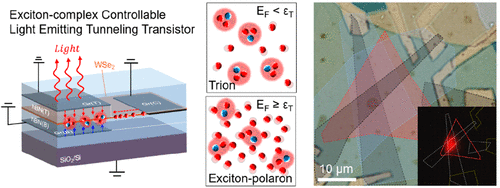当前位置:
X-MOL 学术
›
ACS Photonics
›
论文详情
Our official English website, www.x-mol.net, welcomes your
feedback! (Note: you will need to create a separate account there.)
Electrical Modulation of Exciton Complexes in Light-Emitting Tunnel Transistors of a van der Waals Heterostructure
ACS Photonics ( IF 6.5 ) Pub Date : 2021-11-02 , DOI: 10.1021/acsphotonics.1c01286 Huije Ryu 1 , Junyoung Kwon 2 , Seunghoon Yang 3, 4 , Kenji Watanabe 5 , Takashi Taniguchi 5 , Young Duck Kim 6 , James Hone 7 , Chul-Ho Lee 3, 4 , Gwan-Hyoung Lee 1, 8, 9, 10
ACS Photonics ( IF 6.5 ) Pub Date : 2021-11-02 , DOI: 10.1021/acsphotonics.1c01286 Huije Ryu 1 , Junyoung Kwon 2 , Seunghoon Yang 3, 4 , Kenji Watanabe 5 , Takashi Taniguchi 5 , Young Duck Kim 6 , James Hone 7 , Chul-Ho Lee 3, 4 , Gwan-Hyoung Lee 1, 8, 9, 10
Affiliation

|
Transition metal dichalcogenides (TMDs) and their van der Waals heterostructures provide a unique platform for optoelectronic applications. The strong Coulomb interaction in TMDs creates various tightly bound electron–hole combinations, resulting in various exciton complexes. Despite the great potential of exciton complexes in optoelectronics, most related studies have been performed using optical excitation methods at low temperatures. Here, we demonstrate the electrical modulation of exciton complexes in light-emitting tunnel transistors (LETTs) of van der Waals heterostructures with tunnel junctions of monolayer WSe2 sandwiched by tunnel barriers of hexagonal boron nitride (hBN) and graphene electrodes. Electrons and holes were electrically driven into the monolayer WSe2 by tunneling through hBN, leading to strong electroluminescence (EL) via recombination. To electrically control the exciton complexes by varying the charge balance, we constructed an additional electrode (control electrode) in direct contact with WSe2. We substantially modulated the Fermi energy of WSe2 by direct injection or extraction of electrons from the control electrode, allowing for the modulation of exciton complexes such as excitons, trions, and exciton–polarons, in strong room-temperature EL. This work provides a novel way to electrically stabilize exciton complexes in light-emitting devices of van der Waals heterostructures, which is beneficial for electrically driven excitonic devices.
中文翻译:

范德华异质结构发光隧道晶体管中激子配合物的电调制
过渡金属二硫属化物 (TMD) 及其范德华异质结构为光电应用提供了独特的平台。TMD 中的强库仑相互作用会产生各种紧密结合的电子 - 空穴组合,从而产生各种激子配合物。尽管激子配合物在光电子学中具有巨大潜力,但大多数相关研究都是在低温下使用光激发方法进行的。在这里,我们展示了范德华异质结构的发光隧道晶体管 (LETT) 中激子复合物的电调制,其中单层 WSe 2 的隧道结被六方氮化硼 (hBN) 和石墨烯电极的隧道势垒夹在中间。电子和空穴被电驱动到单层 WSe 2通过穿隧穿 hBN,通过复合产生强电致发光 (EL)。为了通过改变电荷平衡来电气控制激子复合物,我们构建了一个与 WSe 2直接接触的附加电极(控制电极)。我们通过从控制电极直接注入或提取电子来显着调制 WSe 2的费米能量,从而在强室温 EL 中调制激子复合物,如激子、三重子和激子 - 极化子。这项工作提供了一种在范德华异质结构发光器件中电稳定激子配合物的新方法,这对电驱动激子器件是有益的。
更新日期:2021-12-15
中文翻译:

范德华异质结构发光隧道晶体管中激子配合物的电调制
过渡金属二硫属化物 (TMD) 及其范德华异质结构为光电应用提供了独特的平台。TMD 中的强库仑相互作用会产生各种紧密结合的电子 - 空穴组合,从而产生各种激子配合物。尽管激子配合物在光电子学中具有巨大潜力,但大多数相关研究都是在低温下使用光激发方法进行的。在这里,我们展示了范德华异质结构的发光隧道晶体管 (LETT) 中激子复合物的电调制,其中单层 WSe 2 的隧道结被六方氮化硼 (hBN) 和石墨烯电极的隧道势垒夹在中间。电子和空穴被电驱动到单层 WSe 2通过穿隧穿 hBN,通过复合产生强电致发光 (EL)。为了通过改变电荷平衡来电气控制激子复合物,我们构建了一个与 WSe 2直接接触的附加电极(控制电极)。我们通过从控制电极直接注入或提取电子来显着调制 WSe 2的费米能量,从而在强室温 EL 中调制激子复合物,如激子、三重子和激子 - 极化子。这项工作提供了一种在范德华异质结构发光器件中电稳定激子配合物的新方法,这对电驱动激子器件是有益的。











































 京公网安备 11010802027423号
京公网安备 11010802027423号